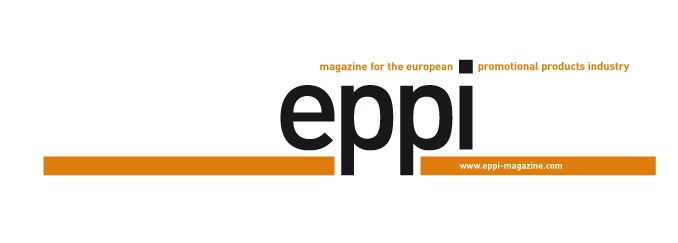For a long time, the promotional products industry was dragging behind on the digitalisation front. Now, companies from other industries with extensive know-how and plenty of capital are forcing their way onto the market. Amazon and Alibaba set standards with regards to delivery periods and worldwide digital connectedness, online printing shops have already implemented individualisation tools and are showing interest in the playing field of haptic advertising. Yet, in spite of all anxiety about the imminent revolutions – this development also holds a great deal of potential.
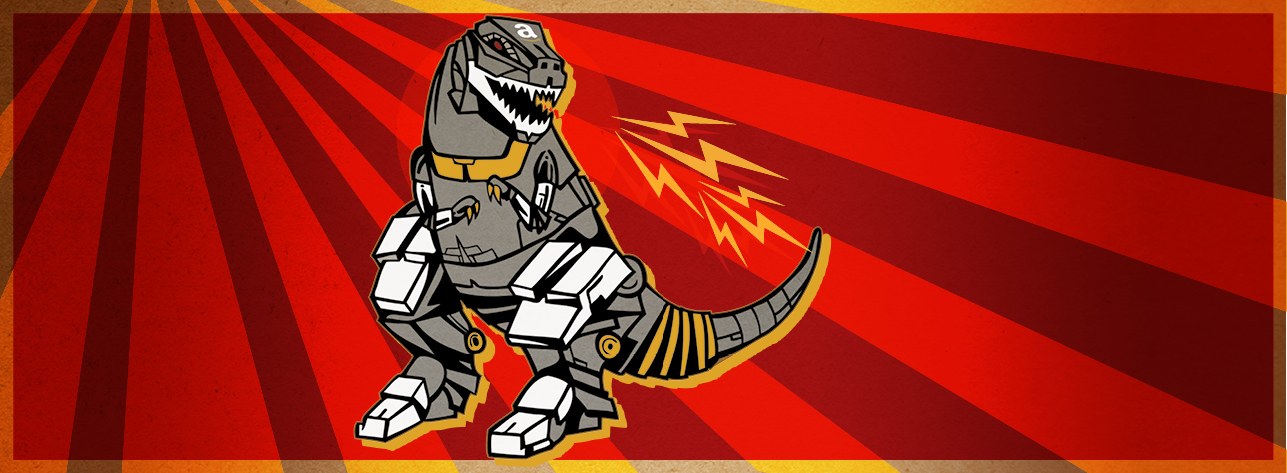
A hard blow for Jeff Bezos: According to the Bloomberg Billionaires Index on 18 November 2019, the Amazon founder is no longer the richest person in the world. With assets totalling 110 billion US dollars, the Microsoft billionaire, Bill Gates, has allegedly overtaken Bezos (Assets: 109 billion US dollars). Several media sources had announced in the summer of 2018 that the value of Bezos‘ assets amounted to over 150 billion US dollars. However, if anyone should take this to be an indication that the Amazon business is not running that well – they are greatly mistaken: The reason for the missing 40 billion dollars is of a purely private nature: Bezos went through a very expensive divorce in the summer. Compared with Bezos and Gates, the reported just under 40 billion US dollar fortune that the Alibaba founder, Jack Ma, allegedly owns, is quite humble. But Ma is not merely just one of the currently estimated 1,800 Chinese dollar billionaires, he is indeed the wealthiest of them – he is commonly known to be the richest person in China and owns around as much as the entire German promotional products industry turned over in the last ten years.
Two giants
What unites Bezos and Ma: They both made their immense fortunes with online trading platforms. Amazon (founded in 1994) and Alibaba (founded in 1999) are icons of the online business and set the benchmarks for successful online shopping. Amazon, which was launched as a mail order business for books, sees itself as the leading global B2C marketplace for goods of all kinds. The business idea is not least based on the connected logistics, which have turned express deliveries – in some cases within 24 hours – into the standard. Alibaba is on the other hand a B2B trading platform via which predominantly Asiatic, but also a growing number of other internationally-operating suppliers, offer their products to companies all over the globe. Both companies strive to expand and permanently develop new business areas – from cloud services to film streaming. Since 2015 Amazon has been successful in the B2B segment represented by Amazon Business, whereas at the end of 2018/ beginning of 2019 the company drew attention to itself with the news that it had purchased a logistics centre in Belgium. While Amazon is pushing its way onto the Chinese market, Alibaba is increasingly setting its sights on the Western markets. At a distance it may be entertaining to an extent to observe this battle of the giants. The only problem is: In the age of the Internet there is no longer any distance. Due to the dynamics and immense capital funds of these two companies every foot that Amazon or Alibaba sets in a new market segment, triggers off a state of shock, which leaves entire industries trembling. Hence, one no longer frequently talks about the two “A brands” of the online business full of admiration, but full of fear they are referred to as the so-called disruptors, who are breaking down the traditional distribution structures, turning markets upside down and ruining margins.
Fear is also spreading across the promotional products market that more and more disruptors from the online business could discover the field of haptic advertising and oust established market players. Recently for instance Cor van Engelenhoven, the founder and CEO of the Dutch online promotional products distributor, Maxilia, made reference in the Dutch industry magazine, PromZ Vak, to the impact of Alibaba’s expansion into the logistics segment for the promotional products industry. If Jack Ma is serious with his announcement that the online pioneer from Hangzhou will be in a position in two years’ time to supply every European with Alibaba products within three days, according to van Engelenhoven, then nobody would need a company like his or midocean any longer. There is however still a big gap between the vision and the status quo. Anyone, who wants to conclude business transactions via the Alibaba platform, needs a minimum of import know-how and an idea of what so-called incoterms like FoB and CIF mean. At the same time, the users have to be prepared to ignore language deficits through to verbal faux pas. For instance, a supplier of iPhone cases made of carbon advertises visiting his country and factory using the beauty of Chinese women: “Great foods, great girls, great view are waiting for you,” promises Tyger Lee of Doolike – it could also be an advertising slogan on the website of a nudist club. Thus, Alibaba is simply – at the present point in time – still not an extensively used alternative for companies that merely want to purchase products for their business requirements in a fast, uncomplicated process. Up until now the Chinese online giant has above all been seen as competition for the classic import business – but so far not for the trade.
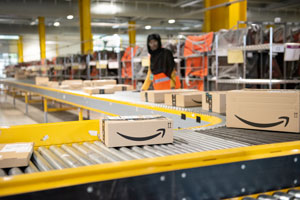
Express delivery, transparency and simplicity: the business idea of Amazon & co. is based on the connected logistics.
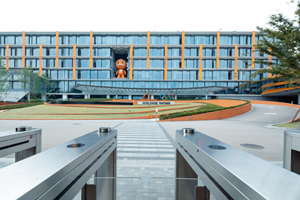
Alibaba headquarters in Hangzhou: The Chinese B2B e-commerce giant is increasingly setting its sights on the Western markets.
Is the promotional products Amazon on the advance?
The situation is different at Amazon: The largest online distributor in the world is often made coresponsible for the fact the stationary retail trade is dying out. Since Amazon launched its business unit, Amazon Business, in 2015, the specialised trade is increasingly also seeing itself confronted with the giant from Seattle. The service for business customers was tailor-made to satisfy the needs of the B2B sector and equipped with functions such as company accounts with several users, the integration of common procurement software and is in the meantime available in Germany, France, Great Britain, Italy, the USA, India and Japan and extremely successfully: In 2018, Amazon published figures according to which the business division made a projected turnover of 10 billion US dollars. There is no longer that much difference between the classic business requirements item and the promotional product, especially since Amazon also individualises the items meanwhile. In the form of Amazon Custom, the suppliers have the opportunity to place products up for sale that can be customised with texts, logos or further product configurations in line with the customers’ requirements. However, Amazon doesn’t have its own promotional products area (yet) – the recently discontinued programme, Amazon Giveaway, was in spite of its name not designed for promotional products, but indeed for prize draws.
Yet, the example shows that Amazon is innovative and simply likes trying something out now and again. Is it therefore just a question of time before Amazon also discovers the international promotional products market? Marcus Schulz, one of the founders of the promotional products online pioneers, Giffits, which in the meantime operates in ten European countries, doesn’t think so: “The promotional products market is no doubt on Amazon’s agenda, but I guess relatively low down on it. They operate very pragmatically and with a turnover of around 3.5 billion Euros in Germany, the industry is rather insignificant for the giant. The efforts involved for tapping into the market stand in no relation to the possible profit.” Pascal Ritter, Director of the business unit, Give-aways, at the online printing company, Flyeralarm, doesn’t con sider Amazon to be “a competitor currently” in this area of products either. However, we are of course keeping a close eye on the developments. On entering new markets, Amazon has frequently proven that it is capable of changing the applicable rules.” At the moment, the margin policy of Amazon doesn’t speak in favour of them entering the promotional products market. In the case of most products, Amazon keeps over 15% of the sales price for itself, here the margin of a promotional products distributor is quickly completely depleted. Having said that, this is of course a business decision that could be changed at any time. But even if Amazon still hasn’t publicly announced its interest in the promotional products market, a different online company may possibly adopt a comparable position. Schulz for instance is convinced: “In the foreseeable future, companies that are at home in the digitalised environment will market promotional products. In five to ten years there will be a globally-operating promotional products Amazon.”
Digitalisation driver
A market shakeout will also take place. “The winners will be the big companies that dispose of plenty of capital. And ultimately in the online sector there is always just one winner,” stated Schulz. Jürgen Geiger, head of the calendar and adhesive memo manufacturer company, Geiger-Notes AG, has also been occupying himself intensely with the consequences of the digitalisation for the promotional products industry and has launched an autonomous company called mypromo, which bundles the offers of the suppliers in order to sell them online directly via distributors as a one-stopshop solution. Geiger is also sure that “a market shakeout will happen”. Whereby according to Geiger, “the big companies won’t necessarily outlive the small companies, but rather the fast-operating companies the slower ones.” Furthermore, it is conceivable that the distribution structures will merge even further: “The traditional borders between the suppliers, manufacturers and distributors will continue to become even more blurred,” said Ritter, who is still far from “merely seeing Amazon as a threat. They are also pioneers in some areas. The absolute customer orientation for example is impressive.” Operating very successfully as a classic online printing company since being founded 17 years ago, today Flyeralarm employs more than 2,300 employees from 70 nations and was able to record a turnover of 350 million Euros last year. Flyeralarm has long since been playing the role of disruptor in the classic printing business and thanks to increased activities could also become active on the haptic advertising market. However, this mustn’t purely be viewed sceptically: “Flyeralarm carries out advertising for the promotional product and thus ensures that the pie becomes slightly bigger,” Geiger finds and Schulze added: “The whole market profits from Flyeralarm’s activities. The more customers learn to implement digital processes, the more professional the entire handling of the promotional products will become.”
Ritter himself also sees his company as an industry “digitalisation driver”. Furthermore, “empirically digitalisation lowers the threshold of a market: As a rule, the prices for products and services drop.” The consequence: For companies that have avoided implementing promotional products so far due to the costs and the difficult processing, haptic advertising will become an easily implementable marketing tool. Insofar, the fact that online printing companies are entering the market expands the reach for all of the promotional products players. This is the way Uli Geyer, Marketing Director of Wir machen Druck, sees it: “Promotional products were considered to be expensive for a long time. We were able to eliminate this prejudice by also showing classic printing customers promotional products at affordable prices in our shop.” Just like the Dutch subsidiary, Vistaprint, Wir machen Druck also belongs to the internationallyoperating Cimpress-Group, which alone because of its two writing instrument subsidiaries, National Pen and Goldstar, has a close association to the promotional products market.
Third wave of eCommerce
To answer the key question, even if nobody should be frightened of the disruptors, it is clear that Amazon & Co. have changed the market enormously over the past years and will continue to do so, particularly because they set standards that all of the market players have to orient themselves on. “With its same-day-delivery policy, Amazon prime has set benchmarks that are also being transferred over into the B2B sector. The delivery times in the promotional products industry have already been cut drastically and will continue to become even shorter,” explained Schulz. Ritter added: “Small order volumes and speed of delivery will in future be decisive factors for the promotional products market.” At Flyeralarm, one is proud for instance that because of their printing know-how and digital process handling they have succeeded in being able to offer imprinted cotton bags using the screen-printing method overnight. One-stop shopping, direct payment, transparency through references, reliable deliveries within a few days – all of this is a comfort the users are familiar with and have become to appreciate from the B2C sector and which they also want to transfer over to the B2B sector. Although the digitalisation brings with it plenty of problems – it also offers decisive advantages. “The digitalisation of the processes – printing data handling and optimisation, approval processes, order placement with sub-contractors, etc. – saves a great deal of time and money,” confirmed Geiger and is convinced: “The demographic change will contribute towards the number of users, who want to also purchase items online in the B2B area, including also print data handling, increasing even further. The classic working time model is gradually becoming obsolete. It is therefore essential for people to be able to shop around the clock.”
Now the industry itself has a backlog demand in the basics of online shopping. So far, many stores have only taken on the function of an initial orientation and point of contact on the web. Indeed, the user often finds several thousands of items – but many shops operated by distributors don’t dispose of an efficient payment solution, not to mention a digital sample approval system. Promotional products buyers are thus forced to contact the company by telephone – a cumbersome task that many avoid, which in turn leads to many of them relying on different advertising media. But even if all of these standards work, the potential of the online sales of haptic advertising is still not exploited, according to Ritter, “the “limits of the digitalisation on the promotional products market have not been reached yet by a long shot.” Schulz is of the opinion that companies with a large database also have an advantage regarding the product selection, because they can present the customers with precise solutions for the task at hand. “We are currently experiencing the third wave of eCommerce, which within a short period of time will progressively cut people out of the buying processes. There will still be product developments on the promotional products market which require the creative input of people, but for approx. 80% of the products sought-after algorithms offer the perfect solution. And this is a basis that big companies will no doubt work on.” Especially since the creativity doesn’t have to fall by the wayside, Schulz finds. “A cool cup with an interesting imprint and personalisation – can be achieved by both people and machines. The digitally generated solution is totally on a par with the version created by a person. In principle, the machine already knows the solution, before the customer even knows he is looking for it.”
Online printing shops on the advance
large share of the promotional products industry – it must be clearly stated – missed the boat when it came down to the development of the digitalisation. A lot of companies simply trusted on old contacts that the haptic advertising market is a face-to-face business, they relied on the fact that the processes are too complicated to cover them using digital means, that practically every order had to be drafted individually. However, the focus on personal dialogue is no longer contemporary. “The market and the buying behaviour of the customers are changing,” Ritter observed. “The start of a transformation within the industry is recognisable, caused by the upcoming, digitally-minded generation.” Ritter’s employer, Flyeralarm GmbH, comes from an industry that is much more advanced with regards to the digitalisation: the printing industry. Flyeralarm is considered to be one of the pioneers of the online printing business. Market players such as the German company, Wir machen Druck, or their Dutch sister company, Vistaprint, Instaprint in Great Britain or Chroma in Poland have also registered huge growth over the past years. They have changed the printing industry sustainably and they master the digitalisation processes, whereas many promotional products players have to go to great lengths to learn inside out. They dispose of a digital infrastructure, have plenty of capital and the respective manpower and a level of recognition that extends far beyond their original business areas. Above all – and this distinguishes them significantly from Amazon & Co. – they possess the necessary machinery and plenty of printing knowhow, which is of a great advantage for the individualising processes.
So, it is hardly surprising that more and more online printing shops are getting involved in the promotional products market. Vistaprint has created an own brand for promotional products within its online offer. Wir machen Druck is exhibiting at the PSI Show for the first time this year. “We added the first promotional product to our line-up shortly after founding the company in the year 2008 and have always considered ourselves to be a partner of the industry,” stated Geyer. “At present promotional products only account for a low one-digit percentage of our overall turnover – whereby we think this market has a huge growth potential.” And Flyeralarm founded the business area Flyeralarm Give Aways in 2017, which it has significantly reinforced over the last two years. 400 promotional products are listed in the main shop, an own promotional products web shop even offers 4,300 products. The team processes almost a six-digit figure of customer orders from 15 European countries a year and with the aid of an own team of consultants, the full-service business is to be boosted from 2020 onwards. According to its own self-image, the company has already “achieved the aim of market leadership” in the promotional products section, Ritter stated. Although the company plays a pioneer role in the digitalisation field, it is incidentally also strongly represented on the analogue channels: The promotional products programme is presented on an own 142-page catalogue full of haptic promotional messengers and a competent team of consultants is to push the expansion of the full-service business. Geiger knows from his own experiences about the power of the online printing shops: “In order to visualise the dimensions and the market power: We made more turnover with one customer from the segment of online printers and one product in ten weeks than we did with a community of distributors and all of our products over the whole year.”
Solutions for distributors
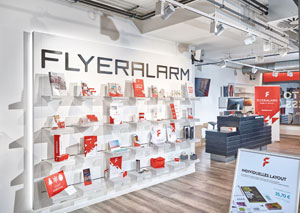
The online printing specialist Flyeralarm has in the meantime launched several retail stores as well as a catalogue dedicated to give-aways.
This recognition was the initial impulse for Geiger to invest in the online business himself: “The online printing shops offer their customers reliable delivery times, a clearly defined programme of standard items and fixed prices. These are clear advantages for which the classic promotional products trade has no answers to-date. One-stop shopping doesn’t exist within the industry yet. mypromo wants to change this.” The idea behind mypromo is almost a kind of cooperative approach. Small promotional products distributors cannot make the investments that are necessary to offer efficient online shops tailormade to suit the needs of the promotional products market. mypromo offers these distributors a white label solution. The distributors’ customers then have the opportunity via mypromo to directly fall back on selected standard products of the participating suppliers, which they can order with a customisation. An automated print data handling and integrated payment solutions turn mypromo into the announced one-stop shop. In addition, it is also possible to integrate the mypromo technology into existing eCommerce systems. Wir machen Druck also offers the promotional products trade similar services. “We make closed procurement portals and open reseller shops available to promotional products distributors via various portal solutions and API connections or act as their production unit – all individualised and with access to our entire portfolio of products,” explained Geyer, who intends to carry on letting the traditional promotional products trade deal with the high-end segment, which is “not as easy to serve using automated processes.” The online printing specialist Flyeralarm has in the meantime launched several retail stores as well as a catalogue dedicated to give-aways. Geiger is also very familiar with practical pitfalls. For example, the classic customising technique used for many products is not digital printing. This causes problems when preparing the data: “Vectorised files have to be created for certain print data. So, we developed a vectorizer especially for the purpose,” reported Geiger, who invested “an exuberant seven-digit Euro amount” in his new project.
Many of the companies that use the mypromo tool, do it out of conviction, some out of fear of being washed away by the digitalisation wave, as Geiger reported. He himself underlines the opportunities of the digitalisation and sees “mypromo as an enhancement to the classic business model of the promotional products consultant. It is about realising small, average orders with standard products at least in three-digit Euro volumes using an automated process which in turn allows the respective company to concentrate on its actual work: consulting work and customer service. Quality, consulting and online distribution channels don’t rule each other out.” Geiger, who has been working in the promotional products industry for over 35 years, still believes in the co-existence of different strategies. “The promotional products world is and will remain to be extremely diversified and heterogeneous – in terms of the products, technologies and distribution channels. The digitalisation of the promotional products industry can only be really successful if it reflects as much of this diversity as possible, not by only supplying digital one-way streets, but instead by networking the market participants digitally in all directions.” The digitalisation – that much is certain – is unstoppable. The promotional products market doesn’t live in a bubble, it will have to fall in step with the changed framework conditions and buying habits. Online is becoming an increasingly more important distribution channel – the future will show whether it is the dominant or perhaps even the only one. Companies from other industries are elbowing their way onto the market – however companies with a future-oriented alignment don’t have to fear these disruptors. Disruptors have no interest in destroying markets, they actually aim to develop them. And with their know-how and capital they contribute towards professionalising the industry. It is also to be assumed that the competitive pressure will increase, whereby this could also result in new customer potential. And well-designed digital solutions help save time, which can be invested into key customer support and the strategical further development of the business. Hence, it should also be possible to earn good money with haptic advertising in the future too. Even if not quite to the same extent as the amounts Jeff Bezos or Jack Ma have amassed.
// Mischa Delbrouck
photos: Flyeralarm (1); Shutterstock/Frederic Legrand – Comeo (1), zhu difeng (1)
Interview with Uli Geyer, Wir machen Druck
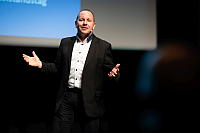 “Automating the high-end segment is not that simple”
“Automating the high-end segment is not that simple”
Through good service and good quality, Wir machen Druck, has fought hard to gain a fixed place within the ranks of the online printers. The company is also becoming increasing more involved in the promotional products area. The Marketing Director, Uli Geyer, about a successful PSI presence, growth potential that can be further exploited and promotional products at affordable prices.
Wir machen Druck had a stand at the PSI Show in 2019: What was the reason for also opening up to the promotional products market?
Uli Geyer: We added the first promotional product to our line-up in the year 2008 shortly after Wir machen Druck was founded and have always seen ourselves as industry partners. The PSI is the ideal platform for establishing and intensifying contacts and in turn for creating synergies, which are worthwhile for both parties – especially thanks to our attractive special conditions for PSI members.
What significance does the promotional products area have for your company?
Uli Geyer: Promotional products only account for a low one-digit percentage of our overall turnover – whereby we do see great growth potential within this market.
Many players on the promotional products market primarily see the online printing companies as competitors for small order quantities of standard items with fast delivery times. Is this perception correct in your opinion?
Uli Geyer: It is comprehensible, however from an objective viewpoint in fact the opposite is the case – the traditional promotional products trade actually benefits a great deal from us! It often entails a lot of effort to organise small volumes and they are expensive to produce. Whereas they can be processed in just a few clicks via our online shop and dispatched on behalf of the contracting company at its calculation costs. This makes small volume orders more attractive for the promotional products distributor – the procurement costs fall and he establishes himself long-term as a solution provider for his customers. Wir machen Druck remains in the background here totally discrete and for the end user the company is not recognisable as the actual supplier.
Do you try to make use of synergies, encouraging your customers from the printing business to buy promotional products as well? Or are you addressing a totally new clientele in the promotional products area?
Uli Geyer: We see ourselves as a full-service provider for practically everything that can be (im)printed. So far particularly our existing customers have profited from our additional offer of promotional products.
Uli Geyer: For a long time, promotional products were considered to be expensive and we were able to eliminate this preconception by presenting promotional products at affordable prices to classic printing customers in our shop. At the same time, promotional products customers discover new opportunities of presenting themselves in a more diversified and professional manner using print media.
What products do you offer in the shop?
Uli Geyer: We offer thousands of products ranging from ballpoint pens to photo gifts, textiles and edible promotional items, through to whole exhibition stands. In addition to the supplier reliability, the individualisability of the products, their quality and of course an advantageous price are important to us. We will continue to leave the high-end segment in the hands of the traditional promotional products trade, because it cannot easily be served using automated processes.
Do you offer further services for promotional products via the online portal?
Uli Geyer: Yes, in different areas. On the one hand, of course simple and favourably-priced personalisations even for small volumes, aligned for processing via the online shop. On the other hand, we are also a kind of infrastructure provider. We make closed procurement portals and open reseller shops available to promotional products distributors via diverse portal solutions and API connections or act as their production unit – all of which is individually aligned and grants access to our entire product range. Including the classic print products, we offer thousands of products in over five million print versions.
What is the difference between the promotional products business and the classic printing business?
Uli Geyer: The promotional products business is quite clearly more trend-driven, faster-paced and the handling is also more laborious than in the case of the classic printing business. However, for us as an eCommerce company this difference is insignificant – product range extensions or changes are everyday occurrences in our day-to-day business.
Can the industry profit from your commitment on the promotional products market?
Uli Geyer: Yes, very strongly indeed. Our regular online shop and the afore-mentioned shop and connection solutions open up a fully new source of supply to the promotional products distributor with preferential conditions for PSI members. On top of this: The digitalisation won’t stop at the gates of the promotional products trade. With our expertise in the field of eCommerce which dates back to our foundation year in 2008, we intend to continue arousing the awareness for the importance and opportunities of the digitalisation within the promotional products industry in the future too, by committing ourselves within organisations like the PSI and making the corresponding infrastructures available. The only thing that is important here is that both sides recognise and seize the opportunities for synergies.
Dr. Mischa Delbrouck spoke with Uli Geyer.
Interview with Pascal Ritter, Flyeralarm Give Aways
 “We see ourselves as a digitalisation driver for the industry”
“We see ourselves as a digitalisation driver for the industry”
Founded in 2002, the Wurzburg-based online printing company, Flyeralarm, is one of the most successful companies in the eCommerce sector. The business unit Flyeralarm Give Aways was established in 2017 under the direction of Pascal Ritter, whose task is to energetically move the company’s entrance onto the promotional products market forward – also in the full-service segment. Flyeralarm’s ambitious aim is to claim market leadership. In an interview with eppi magazine, Pascal Ritter talked about the strategy, advantages and plans of the online pioneer, about cross-selling effects, digital infrastructures and express deliveries that are becoming the standard.
What incited Flyeralarm to found Flyeralarm Give Aways and become active on the promotional products market two years ago?
Pascal Ritter: Flyeralarm is one of the biggest eCommerce companies and is one of Europe’s leading online printing companies in the B2B area. Our aim is to offer our customers a “one-stop-shop solution”, providing everything for the perfect brand identity. Promotional products have always been successful brand ambassadors, which is why it was logical for us to become actively involved in this market. We are very satisfied with the outcome of our market entry after establishing Flyeralarm Give Aways and still see great growth potential. Promotional products are an essential element of the “World of Flyeralarm” and our new slogan “Love your brand” perfectly matches our customers’ requirements.
You have strongly expanded the area within two years – what is the current state of affairs?
We are pursuing a double strategy: In addition to our own online shop (www.Flyeralarm-giveaways.com) that disposes of around 4,300 products, we also offer more than 400 promotional products in our Flyeralarm web shop (www.Flyeralarm.com). The online shop serves as an enhancement to our Flyeralarm shop, on which our clear focus lies. Furthermore, we have laid the foundations to strongly extend the full-service area in 2020. The biggest challenge was ensuring that we could also implement our standardised processes that we are familiar with from Flyeralarm in the full-service area too – we have now formed the basis for this.
Of course, as a core target group, we serve the over 1.5 million Flyeralarm customers, who are acquainted with our services from the Flyeralarm web shop. But of course we address everyone, who is looking for individually imprintable promotional products. We can be satisfied with the development of the orders: Just under two years after the launch, we have almost reached a six-digit number of customer orders per year – with a dynamic upwards trend.
Do your activities in the give-away segment concentrate on Germany or do you have an international alignment?
We think and act internationally: At the moment, we are represented in those 15 European countries, where Flyeralarm is also present. Germany is our home market, we are most strongly represented here in the promotional products sector. However, we will continue to further expand our activities in the other 14 countries too. The internationalisation is extremely important for us and we also aim to successively increase our market share in the other nations as well.
In a press release earlier this spring you self-confidently announced that you are striving to attain market leadership: When do you think this aim can be realistically achieved?
In our self-perception we have already achieved this goal. Alone through our product diversity and the turnovers we make in all product groups that fall under the Give Aways section.
Which advantages do you have compared to other market players in the promotional products sector? And where do you see room for improvement on your part?
The biggest advantages are no doubt the horizontal width of the Flyeralarm line-up, the high brand recognition of Flyeralarm, the high range of over 1.5 million customers in 15 countries as well as our know-how in the printing and digitalisation areas. No other market player can offer this combination, this becomes evident if one takes a look at the range of products for example: As a one-stop shop we can offer a company, regardless of its size, everything for its brand identity: from flyers and office equipment, to roll-ups, exhibition systems and advertising technology, through to online marketing and further digital services as well as – last not least – also promotional products. On top of this, of course, we also profit from the Flyeralarm infrastructure: This includes the completely digitalised ordering process as well as the multi-channel touchpoints for the customer via the web shop, the competent customer service and personal dialogues in the Flyeralarm city centres and lounges.
Above all we see room for improvement in the vertical depth of our product line-up: The 400 promotional products in the Flyeralarm shop are still too few in relation to the overall number of products. We are working flat out to offer from our point of view a full assortment of promotional products by the end of 2020.
What do you reply to traditional distributors, who view the appearance of so-called “disruptors” on the market sceptically or indeed critically?
In my opinion the haptic advertising market can draw significant benefits from us. On the one hand we see ourselves as a digitalisation driver for the industry. As in many other sectors, the digitalisation is also a major theme on the promotional products market. Hence, the market can learn from our processes so that we can create added value for all of the players. On the other hand, empirically the thresholds of a market become lower as a result of the digitalisation: The prices of products and services drop as a rule and the processes become more customer-friendly. This means in the normal case, the digitalisation makes the “pie” bigger because there are simply more potential customers that one can reach as a supplier. The Flyeralarm example has demonstrated this: For instance, today flyers only cost a tenth of what they did in the days before the digitalisation of the printing industry. As a result totally new customer groups were addressed.
Flyeralarm was successful in realigning all of the necessary printing processes so that they are completely digital. Can the experiences achieved in this segment also be implemented for the promotional products market?
Basically, the digitalisation results in the processes becoming more efficient so that even smaller order volumes can be offered and the delivery speeds further increased. The following example clearly shows that at Flyeralarm we also apply our experiences from the printing sector to the promotional products market: We offer cotton bags customised with a screen print – which is more a classic technique. By implementing state-of-the-art production machines, a digital order process and a sophisticated logistics chain we can offer small volumes of cotton bags at competitive prices overnight. The ordering process at Flyeralarm demonstrates what optimised order processing looks like: We work without proof copies in the Flyeralarm shop (for the promotional products too). That means the customer orders directly, the printing data is automatically checked and is subsequently sent on to the printing department. Of course, there are also limits to the digitalisation, but I don’t think we have reached these limits in the promotional products market by a long mark yet.
The promotional products business is traditionally considered to be a face-to-face business, also because many of the workflows are very consulting-intensive especially in the product development area. Does this necessity for personal communication stand in the way of the further digitalisation of the sector?
You are right in saying that the industry is traditionally a face-to face business, however here too both the market and the buying behaviour of the customers is changing. A transformation is beginning to become noticeable within the promotional products market as well, due to the upcoming, digitally-minded generation. Hence we assume that for instance standard products will exclusively be ordered using digital means sooner or later. Nevertheless, the face-to-face business will still have the right to exist in future. For example, personal consulting will continue to be necessary for the full-service segment – and that is a good thing too. This is why we are also relying on competent teams of consultants that are present throughout Germany and Europe. We can implement these teams for the entire Flyeralarm portfolio, which will in turn result in cross-selling effects.
Many players on the promotional products market see Flyeralarm and the other online printing companies primarily as competitors for the small volume orders of standard items with fast delivery times. Do you believe this perception is correct?
This perception is definitely right, from my point of view small order volumes and delivery speed will in future be the success-determining factors on the promotional products market in future. We follow the mass customisation approach: We see our strengths in our product diversity, high quality, the low order quantities and fast delivery times – especially in the case of standard products. Thanks to the above-mentioned digitalised processes we have huge advantages especially in these product areas. And we will be further improving precisely these strengths and won’t merely limit them to cover standard products, but will also expand them to include brand products as well.
Do you also consider Amazon to be a potential competitor in the promotional products sector with its two channels Amazon Business and Amazon Custom?
Not at the moment in this area of products, however we are of course keeping a close eye on the developments. Amazon has frequently proven that it changes the applicable rules on entering new markets. However, I don’t always only see Amazon as a threat, in some areas it is indeed a pioneer. Its absolute customer orientation for instance is impressive.
How do you forecast the development for the next five years – with regards to both Flyeralarm Give Aways and the entire promotional products market?
I think the next five years are going to be trendsetting for the promotional products market, because the market is undergoing transformation and many changes are taking place. I personally see three essential developments overall. On the one hand the traditional borders between the suppliers, manufacturers and distributors are becoming more and more blurred. On the other hand the entire industry has to face the digitalisation issue and satisfy the increased customer expectations. In the era of eCommerce all of the consumers are used to short delivery times and also expect this from the promotional products market. Hence, the trend is clearly going in the direction of express deliveries. The third point is that the price development within the market remains to be a tense issue: An imminent price war would be bad for all market participants.
At Flyeralarm Give Aways we as a team are working on pursuing our positive development. We certainly won’t rest on our laurels, but will instead further optimise and further develop our processes. We will additionally strive to establish ourselves as one of the leading suppliers in Europe for the promotional products sector and set new benchmarks. For example, we will offer more and more promotional products overnight and our express delivery times of two to three days will become our standard delivery times. Because also convenience, i.e. the comfort for the customers, is a top priority in the eCommerce segment, we are constantly expanding our “online design” service. In this way, the customer can design his desired product directly on the PC without graphic knowledge and we automatically receive the print data for the production. Beyond this we are also planning to invest in further machinery for promotional products.
Dr. Mischa Delbrouck spoke with Pascal Ritter.


